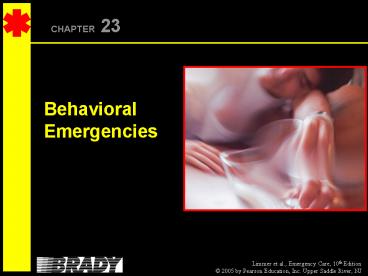Behavioral Emergencies - PowerPoint PPT Presentation
1 / 39
Title:
Behavioral Emergencies
Description:
What are the safety concerns when working with an ... or community Key Term Causes of Behavioral Change Low blood sugar Lack of oxygen Inadequate blood ... – PowerPoint PPT presentation
Number of Views:278
Avg rating:3.0/5.0
Title: Behavioral Emergencies
1
CHAPTER 23
Behavioral Emergencies
2
Causes of BehavioralChange
3
Key Term
Behavior
The manner in which a person acts or performs
4
Key Term
Behavioral Emergency
A situation in which the patient exhibits
abnormal behavior within a given situation that
is unacceptable or intolerable to the patient,
family, or community
5
Causes of Behavioral Change
- Low blood sugar
- Lack of oxygen
- Inadequate blood flow to brain or stroke
- Head trauma
- Continued
6
Causes of Behavioral Change
- Mind-altering substances
- Excessive heat or cold
- Psychological crises
7
Psychological Crises
- Panic
- Agitation
- Bizarre thinking and behavior
- Danger to self
- Danger to others
8
BehavioralEmergencies
9
Behavioral Emergencies
Actions to Take
- Size up scene carefully.
- Identify yourself, your role.
- Inform patient what you are doing.
- Ask questions in a calm, reassuring voice.
- Do not rush.
- Continued
10
Behavioral Emergencies
Actions to Take
- Do not be judgmental.
- Acknowledge patients feelings.
- Show you are listening by rephrasing what is
said. - Treat patient with respect.
11
Assessing BehavioralEmergencies
- What is the patients mental status?
- Appearance (clothing, hygiene)
- Activity
- Speech
- Orientation
- Continued
12
Assessing BehavioralEmergencies
- Any potential violence?
- History of violent behavior
- Posturing
- Voice level/tone
- Physical activity
13
Emergency Care for Behavioral Emergencies
- Maintain a comfortable distance.
- Encourage patient to talk.
- Do not make quick moves.
- Respond honestly to questions.
- Continued
14
Emergency Care for Behavioral Emergencies
- Do not threaten, challenge, or argue.
- Do not play along with visual or auditory
disturbances. - Involve trusted family or friends.
-
Continued
15
Emergency Care for Behavioral Emergencies
- Be prepared to spend time with patient.
- Avoid unnecessary physical contact.
- Use positive eye contact.
- Restrain if necessary.
16
SuicidalBehavior
17
Suicide Risk Factors
- 15-25 years old, or over 40 years old, are high
risk, but any age is possible - Alcohol or drug abuse
- Lethal plan of action
- Gathering articles capable of causing death (gun,
pills, etc.) - Continued
18
Suicide Risk Factors
- Depression or high stress levels
- Previous history of self-destructive behavior
- Recent diagnosis of serious illness
- Recent loss of loved one
- Continued
19
Suicide Risk Factors
- Arrest, imprisonment, loss of job
- Sudden improvement from depression
20
Size-Up During SuicidalBehavior
- Any display of self-destructive behavior or
thoughts? - Illness or injury from previous attempts?
Continued
21
Size-Up During SuicidalBehavior
- How does patient feel?
- Is patient a threat to self/others?
- Is there a medical problem?
22
Safety Considerations
- Have an escape route.
- Never enter a scene alone.
- Be alert for weapons or potential weapons.
- Watch for sudden changes of behavior.
23
Emergency Care for Suicidal Behavior
- Size up scene and your safety concerns.
- Utilize police department as needed.
- Perform patient assessment.
Continued
24
Emergency Care for Suicidal Behavior
- Calm the patient.
- Do not leave patient alone.
- Restrain, if necessary.
- Transport.
25
Use ofRestraints
26
Use of RestraintsMedical-Legal Implications
- Emotionally disturbed patients may refuse care.
- To provide care against patients wishes, patient
must be harmful to self/others.
Continued
27
Use of RestraintsMedical-Legal Implications
- If patient is a threat to self or others, may
transport without consent - May require medical direction
- Usually requires law enforcement
28
Use of Restraints
- Have adequate help.
- Plan ahead.
- Stay clear of patient until prepared.
Continued
29
Use of Restraints
Once a decision is made, act quickly.
- Have one EMTB talk patient through process.
- Secure patient with approved position/ materials.
- Secure all 4 limbs.
Continued
30
Use of Restraints
- Use reasonable force to prevent patient from
injuring self and others. - Avoid force that may injure patient.
Continued
31
Use of Restraints
Reasonable force determined by
- Patients size and strength
- Type of abnormal behavior
- Sex of patient
- Mental state of patient
- Method of restraint
32
Key Term
Positional Asphyxia
- Death of a restrained patient possibly due to
respiratory problems caused by restraint
33
Preventing PositionalAsphyxia
- Do not use hog-tie as a hobble restrain.
- Position patient face-up when possible.
- Monitor patient carefully while restrained.
34
Use of Restraints
- Reassess patient frequently.
- Document incident thoroughly.
- Indications
- Methods
- Witnesses
35
Review Questions
1. List several causes for behavioral change. 2.
Describe several verbal and physical methods for
assessment of a behavioral emergency.
36
Review Questions
3. Describe the patient care for behavioral
emergencies. 4. List several risk factors for
suicide. 5. Describe medical-legal implications
for use of restraints.
37
STREET SCENES
- What is your first and most important concern?
- How should you handle the matter of scene safety?
- When should you approach the patient?
38
STREET SCENES
- How should the patient be approached?
- What are the safety concerns when working with an
agitated patient? - Does this patient need a medical assessment?
39
Sample Documentation































